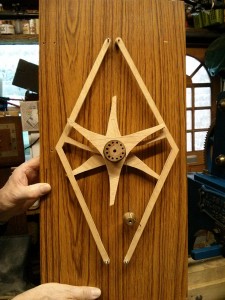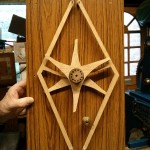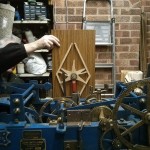There is surprisingly little good information online about how to make a double three-legged gravity escapement. The details had to be pieced together from a number of old books (although some of these can be found online). Although there is information on how to draw out the basic shape there’s not much other detail. A leg length of 4 inches is mentioned in a couple of places, but without stating what size clock that is for. There is little information on material thickness and weight (obviously important on a gravity escapement), one book suggests cutting the parts out of the blade of a carpenters saw. As such, a prototype seemed like a good idea.
The first prototype is made of wood to test out the principal and give a better feel for the scale. The legs on the scape wheel are 4 inches long (8 inch diameter wheel), as mentioned in a couple of the books. From the second picture you can see this makes the escapement too large for this clock. However, the mechanism works nicely and it’s very satisfying to move the pallets side to side (by hand rather than by a pendulum) and watch the scape wheel advance. So we’re pretty happy with the design, we’ve just got to get the scale right now. Unless we can get some measurements from a real clock this will involve trying to take measurements from photos and using items like the arbour supports for scale (not exactly fool-proof).
The main books we used, which have with good info and diagrams:
- Beckett E. A Rudimentary Treatise on Clocks, Watches and Bells For Public Purposes, 8th ed. London: Crosby Lockwood & Son; 1905.
- Goodrich W. The modern clock; A Study of Time Keeping Mechanism; Its Construction, Regulation and Repair. Chicago: Hazlitt & Ealker; 1905.
- Ferson E. The Tower Clock and How to Make It. Chicago: Hazlitt & Walker; 1903.


